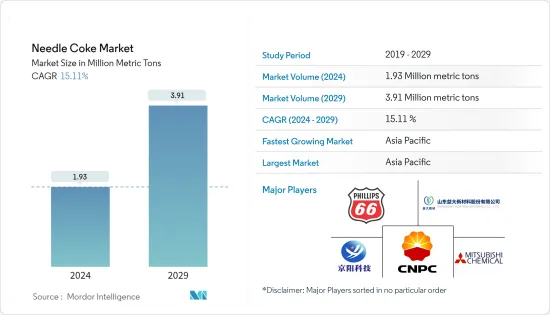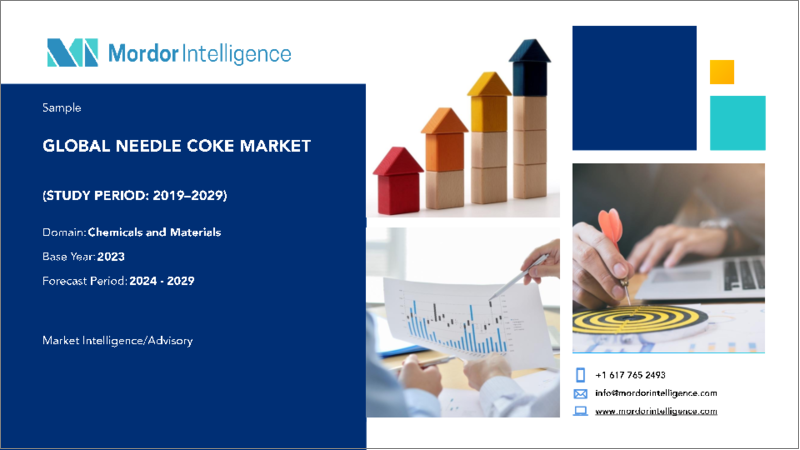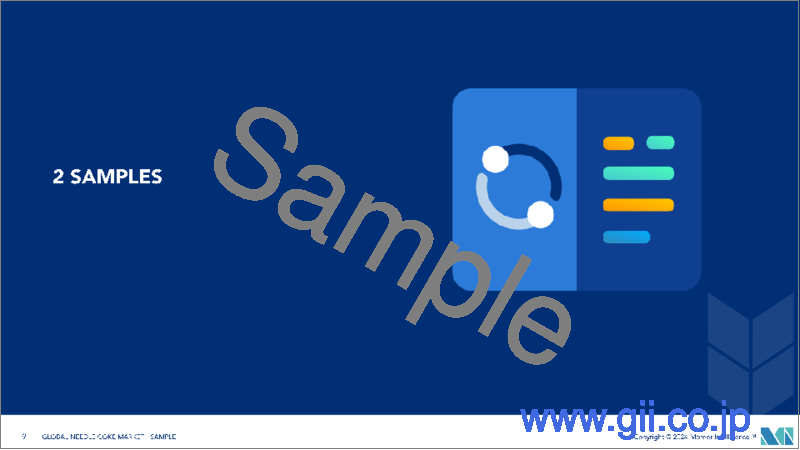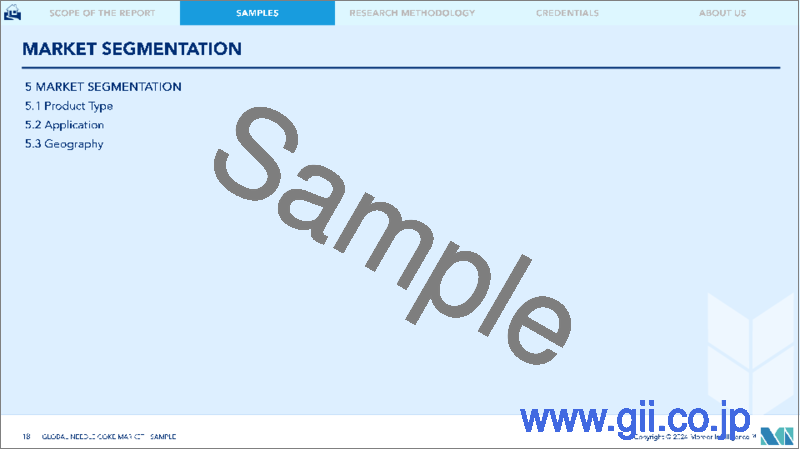|
|
市場調査レポート
商品コード
1536909
ニードルコークス:市場シェア分析、産業動向、成長予測(2024年~2029年)Needle Coke - Market Share Analysis, Industry Trends & Statistics, Growth Forecasts (2024 - 2029) |
||||||
カスタマイズ可能
適宜更新あり
|
|||||||
| ニードルコークス:市場シェア分析、産業動向、成長予測(2024年~2029年) |
|
出版日: 2024年08月14日
発行: Mordor Intelligence
ページ情報: 英文 150 Pages
納期: 2~3営業日
|
- 全表示
- 概要
- 目次
2024年のニードルコークス市場規模は193万トンと推計され、2029年には391万トンに達し、予測期間(2024-2029年)のCAGRは15.11%で成長すると予測されます。

COVID-19パンデミックはニードルコークス市場にマイナスの影響を与えました。パンデミックの間、製鉄所からの需要が減少したため、黒鉛電極の製造に大きな影響を受け、ニードルコークスの消費が減少しました。しかし、リチウムイオン電池と黒鉛電極の需要回復により、規制解除後、市場は大きな成長率を記録しました。
*中期的には、EAF鉄鋼製造への投資の増加と、スクラップ鉄鋼消費を増加させる有利な政府政策が、調査対象市場の成長を促進する重要な要因です。
*しかし、石油コークスに関連する健康被害は、調査した市場の成長を妨げる可能性が高いです。
*世界のリチウムイオン電池生産の増加は、予測期間中、調査市場の好機となりそうです。
*アジア太平洋は支配的な市場として浮上しました。また、インド、中国、日本などの国々からの高い需要により、2024年から2029年にかけて最も高いCAGRで推移すると予想されます。
ニードルコークス市場動向
黒鉛電極セグメントが市場を独占する
*ニードルコークスは、電気炉の黒鉛電極の主原料です。熱膨張係数(CTE)が非常に低い黒鉛電極の製造に使用される、高級で高価値の石油コークスです。
*黒鉛電極は、鉄鋼や他の金属産業で使用される電気アーク炉に広く使用されているため、黒鉛電極用ニードルコークスの用途は、ニードルコークスの最大の用途を占めています。
*黒鉛は熱伝導率が高く、熱や衝撃に強いです。また、鉄を溶かすのに必要な大電流を流すのに必要な電気抵抗も低いです。そのため、EAF(電気炉)で発生する極めて高い熱量に耐えることができます。電極を作るには、コークスを焼成・再焼成して黒鉛にする工程が必要で、半年ほどかかります。
*黒鉛電極は4種類に分けられる:RP黒鉛電極、HP黒鉛電極、SHP黒鉛電極、UHP黒鉛電極。
*黒鉛電極は、主に電気炉鋼、合金鋼、各種合金、非金属の製造に使用されます。これらの電極は高熱を発生させることができ、鋼の精錬や同様の製錬プロセスにも使用されます。電気炉で鉄スクラップを約1600℃で溶かすことができます。
*Sanergy Group Limitedのデータによると、世界の黒鉛電極の生産量は2023年に878万5,000トンで、2024年には79万5,400トンに達すると予測されています。
*2023年12月、グラファイト・インディア・リミテッド(GIL)は、ゴディ・インディア・プライベート・リミテッドの強制転換優先株式に50カロールインドルピー(約600万米ドル)を投資しました。この投資により、GILはゴディ・インディアの株式31%を保有することになります。ゴディ・インディアは、電気自動車(EV)用の持続可能なバッテリーやスーパーキャパシターベースのエネルギー貯蔵システムの生産を支援する先進的な研究開発に取り組んでいます。ゴディ・インディアの環境に優しくカーボンニュートラルなプロセスには、Aqueous Electrode ProcessingTM、Active Dry CoatingTM、Pranic BinderTMなどがあります。今回の投資は、先進的な電池・エネルギー貯蔵技術に多角化するというGILの戦略に沿ったものです。
*2023年11月、HEG社はインドのマディヤ・プラデーシュ州にある黒鉛電極の生産能力を年産80キロトンから100キロトンに拡大することに成功しました。同社はこの生産能力拡大のために1,200カロールインドルピー(1億4,374万1,000米ドル)の巨額投資を行った。その結果、HEGは欧米で第3位の黒鉛電極メーカーとなった。
*上記の要因は、予測期間中、黒鉛電極用途のニードルコークスの需要に影響を与えると予想されます。
アジア太平洋が市場を独占する
*アジア太平洋は、中国(ニードルコークスの最大の生産国であり消費国でもある)や日本のような国々を含むため、ニードルコークス市場を独占すると予想されます。
*中国は、黒鉛電極の消費と生産能力において世界最大のシェアを占めています。中国には40社以上の黒鉛電極メーカーがあります。中国市場の黒鉛電極の需要と、EV産業の成長に後押しされたリチウムイオン電池の負極へのさらなる多様化は、ともにニードルコークスの需要回復の原動力となっています。当面の間、この需要は安定的に増加し、それに対応する価格も上昇すると予想されます。
*これに加えて、中国政府は環境に優しい鉄鋼生産手段の開発にも力を入れています。したがって、中国当局は、炭素排出を抑制し、鉄鋼業界の持続可能性を促進する手段として、電気アーク炉(EAF)技術を積極的に推進しています。EAF技術は、主に鉄スクラップを原料とし、その溶融に電力を使用します。支援的な国家政策に後押しされ、EAF技術の採用は中国で一般的な傾向となり、その結果、黒鉛電極の需要を押し上げることになります。
*日本は、石油、石炭、タール系ピッチニードル・コークスの主要な生産・輸出国のひとつです。日本企業は世界最大の黒鉛電極生産国の一つです。黒鉛電極の市場大手には、昭和電工、日本カーボン、SECカーボン、東海カーボンがあります。
*インドの鉄鋼業界は、脱炭素化への取り組みを強化し、炭素排出量の削減に積極的に取り組んでいます。その一環として、鉄鋼生産に電気炉(EAF)技術を採用する動きが活発化しています。EAFは電力と鉄スクラップに依存しており、従来の方法よりも持続可能な選択肢となっています。
*EAFの採用が進むにつれて、黒鉛電極の需要急増が予想されます。インド政府によるスクラップ輸入関税撤廃の動きは、EAF製鉄メーカーに直接利益をもたらします。有利な国家政策と相まって、これらはEAFへのシフトをさらに促進し、黒鉛電極の需要を促進します。
*日本第2位の鉄鋼メーカーであるJFEスチールは、2023年11月に大規模な電気炉(EAF)の建設計画を発表しました。EAFは、2027年頃までに倉敷工場の既存の高炉に取って代わる予定です。この戦略的な動きは、世界の気候変動イニシアティブに沿った炭素排出の抑制に対する同社のコミットメントを強調するものです。新しい高炉は、主に自動車およびその他のセクターに供給され、年間260万トンの排出削減を見込んでいます。
*黒鉛電極は、鉄鋼生産の主要な方法である電気炉(EAF)プロセスにおいて重要な役割を果たします。韓国の鉄鋼セクターは重要で、自動車、建設、造船などの産業に対応することで、国の経済成長を牽引しています。韓国鉄鋼協会の報告によると、鉄鋼業は韓国のGDPの1.5%、製造業の4.9%を占めています。特に、韓国は世界第6位の鉄鋼生産国です。
*従って、アジア太平洋地域は、上記の観点から世界のニードルコークス市場を独占する可能性が高いです。
ニードルコークス業界の概要
ニードルコークス市場は部分的に統合されています。市場の主要企業(順不同)には、フィリップス66社、中国石油集団(CNPC)、山東易達栄通貿易有限公司、山東京洋科技、三菱化学などがあります。
その他の特典:
- エクセル形式の市場予測(ME)シート
- 3ヶ月間のアナリストサポート
目次
第1章 イントロダクション
- 調査の前提条件
- 調査範囲
第2章 調査手法
第3章 エグゼクティブサマリー
第4章 市場力学
- 促進要因
- EAF鉄鋼製造への投資の増加
- 鉄スクラップ消費拡大のための政府政策
- 抑制要因
- 石油コークスに伴う健康被害
- 業界のバリューチェーン分析
- 業界の魅力度-ポーターのファイブフォース分析
- 供給企業の交渉力
- 買い手の交渉力
- 新規参入業者の脅威
- 代替品の脅威
- 競合の程度
- 価格の概要
第5章 市場セグメンテーション
- 製品タイプ
- 石油ベース
- コールタールピッチベース
- 用途
- 黒鉛電極
- リチウムイオン電池
- その他の用途
- 地域
- アジア太平洋
- 中国
- インド
- 日本
- 韓国
- その他アジア太平洋
- 北米
- 米国
- カナダ
- メキシコ
- 欧州
- ドイツ
- 英国
- イタリア
- フランス
- その他欧州
- 南米
- ブラジル
- アルゼンチン
- その他南米
- 中東・アフリカ
- サウジアラビア
- 南アフリカ
- その他中東・アフリカ
- アジア太平洋
第6章 競合情勢
- M&A、合弁事業、提携、協定
- 市場シェア(%)分析
- 主要企業の戦略
- 企業プロファイル
- Baosteel Group
- China National Petroleum Corporation(CNPC)
- China Petroleum & Chemical Corporation(Sinopec)
- Indian Oil Corporation
- Liaoning Baolai Bioenergy Co., Ltd.
- Mitsubishi Chemical Corporation
- Nippon Steel Corporation
- Phillips 66
- Posco Mc Materials
- Seadrift Coke LP(Graftech International)
- Shandong Dongyang Technology Co. Ltd
- Shandong Yida New Materials Co. Ltd
- Shanxi Hongte Coal Chemical Co. Ltd
第7章 市場機会と今後の動向
- リチウムイオン電池がニードルコークスの需要を押し上げる
The Needle Coke Market size is estimated at 1.93 Million metric tons in 2024, and is expected to reach 3.91 Million metric tons by 2029, growing at a CAGR of 15.11% during the forecast period (2024-2029).

The COVID-19 pandemic negatively impacted the needle coke market. During the pandemic, the manufacturing of graphite electrodes was heavily affected due to less demand from the steel manufacturing plants, which reduced the consumption of needle coke. However, the market registered a significant growth rate after the restrictions were lifted due to the recovering demand for lithium-ion batteries and graphite electrodes.
* Over the medium term, increasing investments in EAF steel manufacturing and favorable government policies to increase scrap steel consumption are significant factors driving the growth of the studied market.
* However, health hazards associated with petroleum coke are likely to hinder the growth of the studied market.
* The increase in lithium-ion battery production globally is likely to act as an opportunity for the market studied during the forecast period.
* Asia-Pacific emerged as the dominant market. It is also expected to register the highest CAGR from 2024 to 2029 due to the high demand from countries such as India, China, Japan, and others.
Needle Coke Market Trends
Graphite Electrodes Segment to Dominate the Market
* Needle coke is a primary raw material for graphite electrodes in electric furnaces. It is a premium-grade, high-value petroleum coke used to manufacture graphite electrodes with a very low coefficient of thermal expansion (CTE).
* Owing to the wide application of graphite electrodes in electric arc furnaces, which are used in steel and other metal industries, the application of needle coke for graphite electrodes accounts for the largest application of needle coke.
* Graphite has high thermal conductivity and is resistant to heat and any impact. Also, it has low electrical resistance, which is needed to conduct large electrical currents necessary to melt iron. Thus, it can sustain extremely high heat levels generated by EAF (electric arc furnace). Making the electrodes requires processing coke, including baking and rebaking, to convert it into graphite, which can take up to six months.
* Graphite electrodes are divided into four types: RP graphite electrodes, HP graphite electrodes, SHP graphite electrodes, and UHP graphite electrodes.
* Graphite electrodes are primarily used to manufacture electric arc furnace steel, alloy steel, various alloys, and nonmetals. These electrodes can generate high levels of heat and are also used in refining steel and similar smelting processes. They can melt iron scrap in an electric arc furnace at about 1,600°C.
* According to data from Sanergy Group Limited, the production volume of graphite electrodes worldwide was 8785 thousand metric tons in 2023 and is projected to reach 795.4 thousand metric tons in 2024.
* In December 2023, Graphite India Limited (GIL) invested INR 50 crore (approximately USD 6 million) in compulsorily convertible preference shares of Godi India Private Ltd. This investment provides GIL with a 31% equity shareholding in Godi India. Godi India is engaged in advanced Research and development to support the production of sustainable batteries for electric vehicles (EVs) and supercapacitor-based energy storage systems. Godi India's environment-friendly and carbon-neutral processes include Aqueous Electrode ProcessingTM, Active Dry CoatingTM, and Pranic BinderTM. This investment aligns with GIL's strategy to diversify into advanced battery and energy storage technologies.
* In November 2023, HEG Limited successfully expanded its graphite electrode capacity in Madhya Pradesh, India, from 80 kilotons per annum to 100 kilotons per annum. The company made a substantial investment of INR 1,200 crore (USD 143.741 million) for this capacity expansion. As a result, HEG is the third-largest graphite electrode company in the Western world.
* The factors mentioned above are expected to affect the demand for needle coke for graphite electrode application during the forecast period.
Asia-Pacific to Dominate the Market
* Asia-Pacific is expected to dominate the needle coke market, as it includes countries such as China (the biggest producer and consumer of needle coke) and Japan.
* China holds the largest share of graphite electrode consumption and production capacity in the global scenario. There are over 40 official graphite electrode manufacturers in China. The Chinese market's demand for graphite electrodes and further diversification into lithium-ion battery anodes, fueled by the EV industry's growth, are both driving a comeback in the demand for needle coke. For the foreseeable future, this demand is expected to continue to increase steadily, with corresponding pricing support.
* In addition to this, the Chinese government is also focusing on developing eco-friendly means of producing steel. Hence, Chinese authorities are actively promoting Electric Arc Furnace (EAF) technology as a means to curb carbon emissions and foster sustainability in the steel industry. EAF technology relies primarily on steel scrap as its raw material, with electricity used to melt it. Driven by supportive national policies, the adoption of EAF technology is poised to become a prevailing trend in China, consequently bolstering the demand for graphite electrodes.
* Japan is one of the leading producers and exporters of petroleum, coal, and tar-based pitch needle coke. Japanese companies are one of the largest producers of graphite electrodes in the world. The market giants of graphite electrodes include Showa Denko, Nippon Carbon, SEC Carbon, and Tokai Carbon.
* The Indian steel industry is actively working to reduce carbon emissions through intensified efforts to decarbonize. As part of this push, there is a rising trend in adopting electric arc furnace (EAF) technology for steel production. EAFs rely on electricity and steel scrap, making them a more sustainable choice than traditional methods.
* With the growing adoption of EAFs, there is a significant expected surge in demand for graphite electrodes. The Indian government's move to eliminate customs duty on scrap imports directly benefits EAF steel manufacturers. Coupled with favorable national policies, these further fuel the shift toward EAFs and drive the demand for graphite electrodes.
* JFE Steel, Japan's second-largest steelmaker, announced in November 2023 its plans to construct a large-scale electric arc furnace (EAF). The EAF is slated to replace an existing blast furnace at its Kurashiki plant by around 2027. This strategic move underscored the company's commitment to curbing carbon emissions, which is in line with global climate change initiatives. The new EAF will primarily cater to automotive and other sectors, with an anticipated annual emissions reduction of 2.6 million tons.
* Graphite electrodes play an important role in the electric arc furnace (EAF) process, a key method for steel production. The steel sector in South Korea is significant, driving the nation's economic growth by catering to industries like automotive, construction, and shipbuilding. The steel industry accounts for 1.5% of the nation's GDP and 4.9% of its manufacturing sector, as reported by the Korean Iron & Steel Association. Notably, South Korea ranks as the sixth-largest steel producer globally.
* Hence, Asia-Pacific is likely to dominate the global needle-coke market based on the aspects mentioned above.
Needle Coke Industry Overview
The needle coke market is partially consolidated. Some of the major players in the market (not in any particular order) include Phillips 66 Company, China National Petroleum Corporation (CNPC), Shandong Yida Rongtong Trading Co., Shandong Jing Yang Technology Co. Ltd, and Mitsubishi Chemical Corporation.
Additional Benefits:
- The market estimate (ME) sheet in Excel format
- 3 months of analyst support
TABLE OF CONTENTS
1 INTRODUCTION
- 1.1 Study Assumptions
- 1.2 Scope of the Study
2 RESEARCH METHODOLOGY
3 EXECUTIVE SUMMARY
4 MARKET DYNAMICS
- 4.1 Drivers
- 4.1.1 Increasing Investments in EAF Steel Manufacturing
- 4.1.2 Government Policies to Increase Scrap Steel Consumption
- 4.2 Restraints
- 4.2.1 Health Hazards Associated with Petroleum Coke
- 4.3 Industry Value-Chain Analysis
- 4.4 Industry Attractiveness - Porter's Five Forces Analysis
- 4.4.1 Bargaining Power of Suppliers
- 4.4.2 Bargaining Power of Buyers
- 4.4.3 Threat of New Entrants
- 4.4.4 Threat of Substitute Products and Services
- 4.4.5 Degree of Competition
- 4.5 Price Overview
5 MARKET SEGMENTATION (Market Size in Volume)
- 5.1 Product Type
- 5.1.1 Petroleum Based
- 5.1.2 Coal-tar Pitch Based
- 5.2 Application
- 5.2.1 Graphite Electrodes
- 5.2.2 Lithium-ion Batteries
- 5.2.3 Other Applications
- 5.3 Geography
- 5.3.1 Asia-Pacific
- 5.3.1.1 China
- 5.3.1.2 India
- 5.3.1.3 Japan
- 5.3.1.4 South Korea
- 5.3.1.5 Rest of Asia-Pacific
- 5.3.2 North America
- 5.3.2.1 United States
- 5.3.2.2 Canada
- 5.3.2.3 Mexico
- 5.3.3 Europe
- 5.3.3.1 Germany
- 5.3.3.2 United Kingdom
- 5.3.3.3 Italy
- 5.3.3.4 France
- 5.3.3.5 Rest of Europe
- 5.3.4 South America
- 5.3.4.1 Brazil
- 5.3.4.2 Argentina
- 5.3.4.3 Rest of South America
- 5.3.5 Middle East and Africa
- 5.3.5.1 Saudi Arabia
- 5.3.5.2 South Africa
- 5.3.5.3 Rest of Middle East and Africa
- 5.3.1 Asia-Pacific
6 COMPETITIVE LANDSCAPE
- 6.1 Mergers and Acquisitions, Joint Ventures, Collaborations, and Agreements
- 6.2 Market Share (%) Analysis
- 6.3 Strategies Adopted by Leading Players
- 6.4 Company Profiles
- 6.4.1 Baosteel Group
- 6.4.2 China National Petroleum Corporation (CNPC)
- 6.4.3 China Petroleum & Chemical Corporation (Sinopec)
- 6.4.4 Indian Oil Corporation
- 6.4.5 Liaoning Baolai Bioenergy Co., Ltd.
- 6.4.6 Mitsubishi Chemical Corporation
- 6.4.7 Nippon Steel Corporation
- 6.4.8 Phillips 66
- 6.4.9 Posco Mc Materials
- 6.4.10 Seadrift Coke LP (Graftech International)
- 6.4.11 Shandong Dongyang Technology Co. Ltd
- 6.4.12 Shandong Yida New Materials Co. Ltd
- 6.4.13 Shanxi Hongte Coal Chemical Co. Ltd
7 MARKET OPPORTUNITIES AND FUTURE TRENDS
- 7.1 Lithium-ion Batteries to Boost the Demand for Needle Coke





